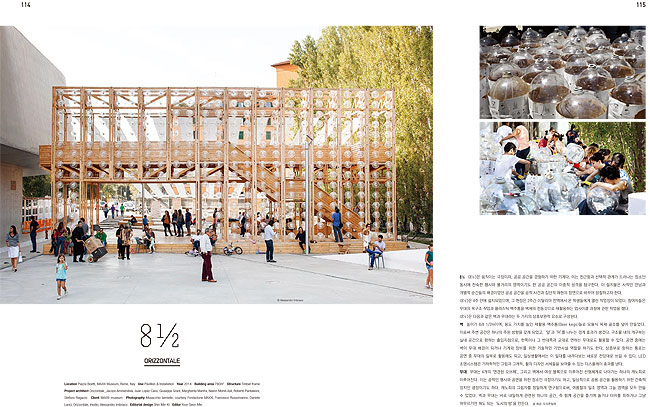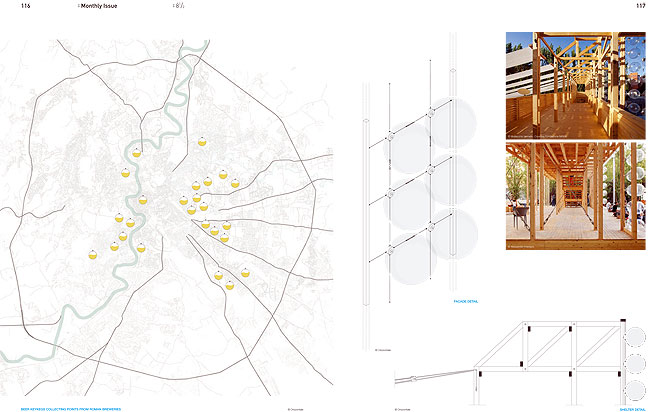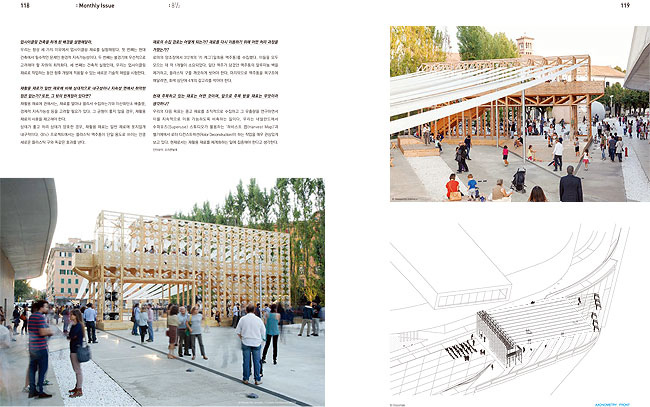8½
orizzontale



8½ <8½>은 움직이는 극장이자, 공공 공간을 경험하기 위한 기계다. 이는 친근함과 선택적 관계가 드러나는 장소인 동시에 친숙한 행사와 볼거리의 영역이기도 한 공공 공간의 이중적 성격을 탐구한다. 이 설치물은 사적인 만남과 개별적 순간들의 배경이었던 공공 공간을 공적 사건과 집단적 재현의 장면으로 바꾸어 성찰하고자 한다. <8½>은 4주 만에 설치되었으며, 그 현장은 2주간 이탈리아 전역에서 온 학생들에게 열린 작업장이 되었다. 참여자들은 무대의 목구조 작업과 플라스틱 맥주통을 벽체의 전등갓으로 재활용하는 업사이클 과정에 관한 작업을 했다. <8½>은 다음과 같은 벽과 무대라는 두 가지의 상호보완적 요소로 구성된다.
벽 높이가 8과 1/2m이며, 용도 가치를 높인 재활용 맥주통(Beer kegs)들로 모듈식 목재 골조를 덮어 만들었다. 이로써 주변 공간은 하나의 주된 방향을 갖게 되었고,‘ 앞’과‘ 뒤’를 나누는 경계 효과가 생겼다. 구조물 내의 개구부는 실내 공간으로 향하는 출입지점으로, 한쪽이나 그 반대쪽과 교대로 면하는 무대로도 활용할 수 있다. 공연 중에는 벽이 무대 배경이 되거나 기계와 장비를 위한 기술적인 기반시설 역할을 하기도 한다. 상층부로 향하는 통로는 공연 중 무대의 일부로 활용해도 되고, 일상생활에서는 이 일대를 내려다보는 새로운 전망대로 쓰일 수 있다. LED 조명시스템은 기하학적인 그림과 그래픽, 활자 디자인 서체들을 보여줄 수 있는 디스플레이 효과를 낸다.
무대 무대는 4개의‘ 연관된 오브제’, 그리고 벽에서 여섯 블록으로 이루어진 선형체계로 나아가는 하나의 캐노피로 이루어진다. 이는 공적인 행사와 공연을 위한 장소인 극장이기도 하고, 일상적으로 공용 공간을 활용하기 위한 건축적 장치인 광장이기도 하다. 캐노피의 그림자를 정밀하게 연구함으로써, 여름철의 일조 영역과 그늘 영역을 모두 만들 수 있었다. 벽과 무대는 서로 내밀하게 관련된 하나의 공간, 즉 함께 공간을 즐기며 놀거나 더위를 피하거나 그냥 머무르기만 해도 되는 ‘도시의 방’을 만든다. 글 제공: 오리쫀탈레
업사이클링 건축을 하게 된 배경을 설명해달라.
우리는 항상 세 가지 이유에서 업사이클링 재료를 실험해왔다. 첫 번째는 현대 건축에서 필수적인 문제인 환경적 지속가능성이다. 두 번째는 불경기에 우선적으로 고려해야 할 자원의 최적화다. 세 번째는 건축적 실험인데, 우리는 업사이클링 재료로 작업하는 동안 향후 개발에 적용할 수 있는 새로운 기술적 해법을 시험한다.
재활용 재료가 일반 재료에 비해 상대적으로 내구성이나 지속성 면에서 취약한 점은 없는가? 또한, 그 밖의 한계점이 있다면?
재활용 재료에 관해서는, 재료를 얼마나 멀리서 수집하는가와 이산화탄소 배출량, 경제적 지속가능성 등을 고려할 필요가 있다. 그 균형이 좋지 않을 경우, 재활용 재료의 사용을 재고해야 한다. 상태가 좋고 처리 상태가 양호한 경우, 재활용 재료는 일반 재료에 못지않게 내구적이다. <8½> 프로젝트에서는 플라스틱 맥주통이 단일 용도로 쓰이는 만큼 새로운 플라스틱 구와 똑같은 효과를 낸다.
재료의 수집 경로는 어떻게 되는가? 재료를 다시 이용하기 위해 어떤 처리 과정을 거쳤는가?
로마의 양조장에서 312개의‘ 키 케그’(일회용 맥주통)를 수집했다. 이들을 모두 모으는 데 약 1개월이 소요되었다. 일단 맥주가 담겼던 맥주통의 알루미늄 백을 제거하고, 플라스틱 구를 깨끗하게 씻어야 한다. 마지막으로 맥주통을 목구조에 매달려면, 회색 상단에 4개의 갈고리를 박아야 한다.
현재 주목하고 있는 재료는 어떤 것이며, 앞으로 주목 받을 재료는 무엇이라 생각하나?
우리의 다음 목표는 중고 재료를 조직적으로 수집하고 그 유출량을 연구하면서 이를 지속적으로 이용 가능하도록 비축하는 일이다. 우리는 네덜란드에서 수퍼유즈(Superuse) 스튜디오가 활용하는‘ 하비스트 맵(Harvest Map)’과 벨기에에서 로터 디컨스트럭션(Rotor Deconstruction)이 하는 작업을 매우 관심있게 보고 있다. 현재로서는 재활용 재료를 체계화하는 일에 집중해야 한다고 생각한다. 인터뷰이: 오리쫀탈레
<8½> is a mobile theatre, a machine to experience public space. It investigates the dual nature of public space, as the place of intimacy and elective relationships and in the meantime the preferential territory of event and spectacle. The installation intends to be a reflection about the transition that changes public space from being the background of private encounters and individual moments to being the scene of public events and collective representations. <8½> was built in 4 weeks, the construction site became for 2 weeks a workshop open to students from all over Italy. The participant worked on the wooden structures of the arena and on the upcycle process of plastic beer kegs into lampshades for the wall.
<8½> consists of two complementary elements: the wall & the arena: The wall 8 and 1/2 meters high, is built with modular timber frames covered with upcycled beer kegs. It transforms the surrounding space laying down a principal direction and creates a threshold effect dividing the “front” from the “back”. An opening in the structure can be used as access point to the interior space and as stage alternatively facing one side or the other. During the plays, the wall works as scaenae frons, backdrop or technical infrastructure for machines and equipment. A path climbing to an upper level can be used during the shows as a part of the stage or, in the everyday life, as a new point of view over the area. The LED lighting system works as a display that can show geometrical drawings, graphics, typographic fonts.
The arena it consists in four “relational objects” and a canopy that goes from the wall to a linear system composed by six blocks. The arena is both a theatre, a place addressed to public events and plays, and a square, an architectural device for the daily use of the common space. An accurate shadow study of the canopy allows both shaded and sunny areas during summertime. The wall and the arena work together creating an intimate relational space, an “urban room” where you can enjoy the space together, play, chill or simply stay.
Text offer: orizzontale
Please explain in what background you've come to make upcycling architecture.
We have always experimented with upcycled material for three reasons: environmental sustainability, essential matter for contemporary architecture; resource optimization, primary consideration in a recession time period; architectural experimentation, while working on the upcycled material we test new technical solutions to be applied in a future development.
Isn't there any aspect of recycled materials to be less durable or less sustainable than general materials? As well, what else could be the disadvantage of recycled materials?
While talking about recycled materials we need to consider where you collect them in term of distances, CO2 emissions and economic sustainability. When the balance is negative you need to reconsider the use of recycled material. If the recycled material is in a good shape and it is well treated, it is as durable as general materials. Concerning <8½> project, the plastic keykegs have a single-use and they come exactly as new plastic spheres.
In what ways have you acquired the materials? What processes were required for reusing them?
We collected 312 key-kegs in the roman breweries. It took us approx. 1 month to have them all. The key kegs need to be emptied of the aluminium bag, earlier full of beer; then the plastic sphere needs to be clean. Last, you need to screw 4 hooks in the grey top to hang the key kegs to the wooden structure.
What material are you looking at now? And do you think what material will get much attention in the future?
Our next goal is to organize the collection of used materials, to study the fluxes and to stock them for having a constant availability. We look at the Superuse's Harvestmap in Holland and the Rotor Deconstruction experience in Belgium with great interest. We think that the systematization of the recycled material is the matter to focus on right now.
Interviewee: orizzontale
건축문화 2016년 8월호 [Monthly Issue]페이지 © 에이엔씨출판(주)